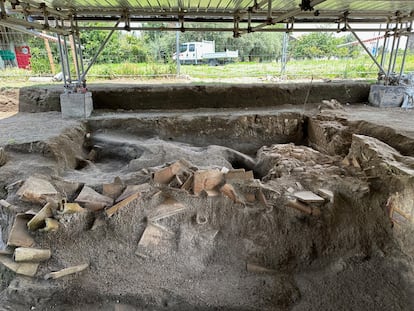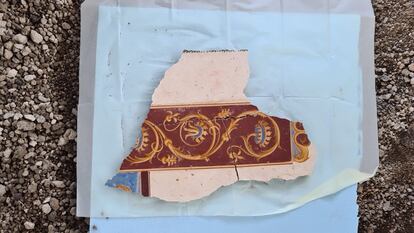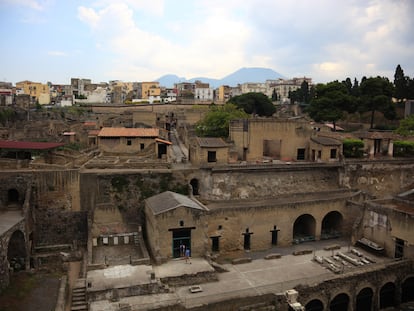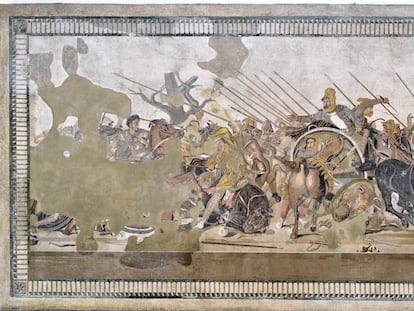The calm before the storm: How Vesuvius deceived the inhabitants of Stabiae, Rome’s ‘little Pompeii’
Excavations in the devastated city reveal new details about the dynamics of the eruption and have uncovered paintings and architectural remains of extraordinary quality

There was a brief moment, before the final destruction, when the inhabitants of the small city of Stabiae, 2.7 miles from Pompeii, thought that the worst was over and the events of that fateful autumn day in 79 AD, when Vesuvius awoke and began to roar, had passed them by. After the initial tremors, when the rain of ash seemed to have stopped, residents emerged from the improvised hiding places where they had taken refuge in the summer resort that catered to elites of ancient Rome, a place full of luxury villas. Once in the open air and exposed in their gardens, they were overwhelmed by a destructive fury, accompanied by a dense and scorching wind, that submerged the city under tons of burning rocks, lava, and other pyroclastic material.
The archaeologists who have been working on a new excavation campaign since March have been able to reconstruct the effect of the eruption on Stabiae, which was known as “little Pompeii” and became a place of leisure for the Roman aristocracy at the end of the 1st century BC, popular due to it monumental villas, most of which have yet to be excavated.
It was in Stabiae that the writer, historian and naturalist Pliny the Elder, Vesuvius’ most famous victim, perished. His nephew, Pliny the Younger, authored the most important chronicles of the eruption and his letters recount how ash and lava covered and raised the floor level of the courtyard overlooking his uncle’s room. He described the atmosphere in such detail that volcanologists applied his name to high explosive volcanic eruptions characterized by the expulsion of a huge column of gases and pyroclastic material like that of Vesuvius — a Plinian eruption.
Although it is an archaeological site of outstanding historical value, Stabiae has remained in the shadow of neighboring Pompeii and Herculaneum. Unlike them, it suffered less damage, being somewhat further away from the volcano, and was inhabited again following the eruption.

The latest findings offer valuable scientific documentation of what happened in those courtyards, elegant gardens and in the rooms where daily life was shattered when the earth began to tremble.
By studying the stratigraphy of the lapilli layers — comprised of small volcanic stones expelled during an eruption — and the buried remains, archaeologists have reconstructed the phases of the destruction process and confirmed that the volcanic eruption that turned the city into an inferno happened in several stages.
Experts admit that they do not know why Stabiae’s inhabitants left their shelters. But by analyzing the remains of the extraordinary Villa San Marco, a large complex of more than 11,000 square meters located in the old part of the city, they have found that at first a rain of gray lapilli fell on the city and accumulated on its roofs, entered the portico through the columns. Then, the larger sections of roof eventually collapsed under the weight of the volcanic material. Finally, the pyroclastic flow swept away what was left standing.

Despite the destruction, the life and luxury of the villa have risen from the ashes during archaeological excavations, which have brought to light the rich chromatic ranges of paintings on the walls and ceilings, stuccoes, capitals, paraments and crowns of the columns and roofs.
The site of Stabiae was reopened in 2020 and various excavations have been undertaken since then. Villa San Marco had already been excavated at the beginning of the Bourbon era (in the 18th century), when, under the reign of Charles III, restoration work began that brought Pompeii and its neighboring cities out of oblivion. In the 1950s and 1960s, under the leadership of archaeologist Libero D’Orsi, it was once again excavated and restored. The luxurious residence underwent another restoration after it was damaged in the 1980 earthquake.
The Villa San Marco complex has emerged from the lapilli in its original layout: it is divided into a large sector with a double atrium and thermal baths, a lower garden with colonnades and a large pond crowned to the east and west by refined living and recreation areas. The structure ends with a monumental three-armed upper portico that opens onto the sea. The beginning of the latter structure had already been identified, but the remainder has only been uncovered in recent years, 100 meters from the corner that is preserved today. There is still a section that remains to be excavated.

The paintings that have been uncovered in an exceptional state of preservation display carpets, candelabra, and mythological scenes, as well as architectural models with deep perspectives often painted in different shades of blue. The walls contain figures seated on the architectural impressions and mythological representations.
The latest findings consolidate this corner of the peaceful Bay of Naples on the map of international archaeological research. The Italian Ministry of Culture reports that there is still much at the site that remains to be unveiled.
Sign up for our weekly newsletter to get more English-language news coverage from EL PAÍS USA Edition
Tu suscripción se está usando en otro dispositivo
¿Quieres añadir otro usuario a tu suscripción?
Si continúas leyendo en este dispositivo, no se podrá leer en el otro.
FlechaTu suscripción se está usando en otro dispositivo y solo puedes acceder a EL PAÍS desde un dispositivo a la vez.
Si quieres compartir tu cuenta, cambia tu suscripción a la modalidad Premium, así podrás añadir otro usuario. Cada uno accederá con su propia cuenta de email, lo que os permitirá personalizar vuestra experiencia en EL PAÍS.
¿Tienes una suscripción de empresa? Accede aquí para contratar más cuentas.
En el caso de no saber quién está usando tu cuenta, te recomendamos cambiar tu contraseña aquí.
Si decides continuar compartiendo tu cuenta, este mensaje se mostrará en tu dispositivo y en el de la otra persona que está usando tu cuenta de forma indefinida, afectando a tu experiencia de lectura. Puedes consultar aquí los términos y condiciones de la suscripción digital.
More information
Archived In
Últimas noticias
Most viewed
- Sinaloa Cartel war is taking its toll on Los Chapitos
- Oona Chaplin: ‘I told James Cameron that I was living in a treehouse and starting a permaculture project with a friend’
- Reinhard Genzel, Nobel laureate in physics: ‘One-minute videos will never give you the truth’
- Why the price of coffee has skyrocketed: from Brazilian plantations to specialty coffee houses
- Silver prices are going crazy: This is what’s fueling the rally











































